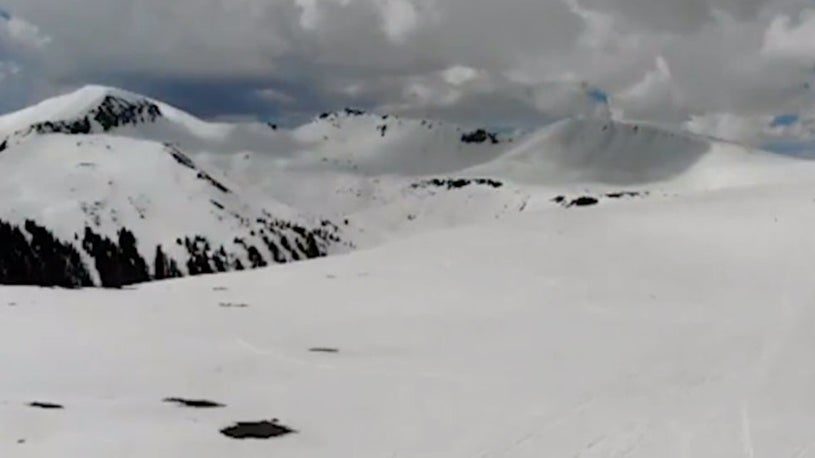The snow arrived first in the Olympics and Cascades of the Pacific Northwest Thursday and early Friday, dusting parts of Olympic and Mt. Rainier National Parks, Washington. It was snowing in the Oregon Cascades Thursday night as low as the 4,766-foot summit of Santiam Pass, about 70 miles east of Corvallis.
Snow then spread into the northern Rockies Friday into the weekend, with most accumulations above 6,000 feet, but there were some slushy accumulations as low as 5,000 feet elevation in southwest Montana, according to the National Weather Service.
Would you look at all this June Snow?? pic.twitter.com/10lIiDkr4R
— Sunshine Village (@SunshineVillage) June 7, 2019
daybreak snow--Mt. Hood Oregon, and Mt. Rainier WA #wawx pic.twitter.com/HUYSyTyir4
— NWS Seattle (@NWSSeattle) June 8, 2019
A winter weather advisory was issued for the Absaroka and Beartooth Mountains through Sunday morning, where 4 to 8 inches of total snow was expected.
Fresh snow in the park last night. Good reminder to check the weather before your trip and always pack extra layers! #SpringInTheRockieshttps://t.co/PLFme02bRx pic.twitter.com/gNL3VG3COy
— YellowstoneNPS (@YellowstoneNPS) June 8, 2019
One mountain location south-southeast of Livingston, Montana, reported 9.5 inches of new snow Saturday morning.
As the upper-level cold pocket of air pivoted over Montana Saturday, hail up to peanut-size accumulated on streets in Bozeman.
@NWSGreatFalls heavy pea to peanut 🥜 sized hail in Bozeman. Has been going on for about 5-6 minutes. pic.twitter.com/hp9shgf89R
— Patrick Joyce (@pdj458) June 8, 2019
Saturday morning, some roads above 6,000 feet in eastern Idaho were snow covered. Three inches of snow was reported in the mountains of southeast Idaho south of Soda Springs, about 45 miles southeast of Pocatello.
It's a Snowy (and even slippery) Saturday June morning across portions of our area. Here's a roundup of the snowiest Webcam images so far this morning. #idwx pic.twitter.com/i7hFttoXnG
— NWS Pocatello (@NWSPocatello) June 8, 2019
This snow also extended into the Canadian Rockies, making ski and snowboarders long for a few June runs near Banff, Alberta.
June snowfall in the Rockies is quite common. Yellowstone Lake, Wyoming, averages 1.2 inches of snow each June.
Denver once picked up measurable snow as late as June 2, 1951, and a trace of snow as late as June 12, 1947.
Even where it wasn't snowing, lingering snowpack in parts of the mountain West remained massive by early June standards.
The water content of Colorado snowpack was estimated to be 654 percent of the average for June 5, and over 51 times that of one year ago, according to the USDA's Natural Resources Conservation Service.
According to the National Weather Service in Boulder, only three other years since 1979 had a higher snowpack in early June in the upper Colorado and South Platte River basins.
This prompted a partial draining of Dillon Reservoir in Summit County — the primary drinking water supply for over a million residents in the Denver metro area — to guard against flooding once summer runoff accelerates.
Crews were finally able to fully open Trail Ridge Road through Colorado's Rocky Mountain National Park Wednesday, the latest full opening of the 48-mile long road in eight years, 12 days later than last year.
The high snowbanks of Trail Ridge Road #Colorado 2019. 📷: Judi Schwandt #9wx pic.twitter.com/4MCvkkyjkl
— Cory Reppenhagen (@CReppWx) June 8, 2019
Plow drivers typically encounter drifts up to 22 feet when they begin plowing in mid-April, with a goal of opening the road by Memorial Day weekend. The Alpine Visitor Center near the road's highest elevation opened Thursday.
Snowpack in California's Sierra also remains remarkable for early June.
According to NOAA's California Nevada River Forecast Center, the water content of the Sierra snowpack ranges from two to over four times the early June average.
Squaw Valley reported a 150-inch base on its upper mountain Saturday. A SNOTEL station at Leavitt Lake in the southern Sierra estimated a 141-inch snowpack.
It is estimated 150 lakes in California's Tahoe Basin above 7,000 feet elevation are still frozen, SFGate reported.
"I've seen it happen only a few times over the past 40 years," Don Lane, supervisory recreation forester for the U.S. Forest Service told SFGate.
According to onthesnow.com, Mammoth Mountain, Squaw Valley and Donner Ski Ranch remain open in the Sierras.




Reader Comments
shit flies toooooo
Best of the Web: Former US defense official: 'We know UFOs exist, the issue is why are they here?'
After a bombshell report detailing near-daily interactions with unidentified flying objects by Navy pilots in 2014 and 2015, Christopher Mellon has argued that this information is nothing new, and...It is in fact expanding.
It does not bode well, as the Southern hemisphere, is cooling down at an impressive rate.
Mankind has not been misinformed, no, lied to.
Those who spun this Tosh and nonsense, of " Global warming, climate change", need to be brought to account.